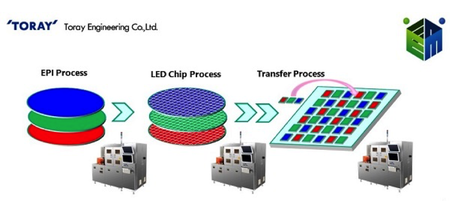Vertical Divider
|
Toray Gears Up for Micro LEDs with Test Equipment
January 22, 2018 Toray Engineering, a Japan-based production facilities company, has a long history of providing manufacturing and testing equipment specifically for both the semiconductor and display industries. Kotera introduced at 2017 Micro LED International Symposium the company’s semiconductor-level testing equipment, the INSPECTRA series, which is able to test and control the quality of Micro LEDs using photoluminescence (PL) tests. Figure 1 Toray's Micro LEDs Test Equipment Process Source: Toray Engineering
Photoluminescence (PL) inspection refers to a testing method to assess the status or quality of a substance from its emission of light after absorbing visible or ultraviolet light, also known as fluorescence. The energy of the light source is normally higher than the band gap to trigger the effect. Toray has downsized this technology to be a micro PL (μ PL) measurement, through which optical signals are created and transmitted to the computer that later processes the calculation and forms images based on the firm’s self-developed algorithms, Kotera explained. The inspection is conducted 100% automatically at high speed and intended for both frontend and backend wafer processing. PL imaging is not a new approach as it is long used for testing other applications such as PV cells, whereas it could be innovative when it comes to inspection of optical devices such as LED, compared to electroluminescence (EL) testing. EL testing, on the other hand, inspects defects by giving an electric current that passes through devices to see if they emit light or not. It often proceeds with a probe contact. However, incumbent probes- even if some of them are with the smallest lateral size of 125μm- is not small enough to test parameters of Micro LED. The contact-based test might even damage the chips. “Testing with light enables simple and quick inspection of several million chips on a wafer and the advantage makes our machine an effective alternative to the probe inspection,” said Kotera. The INSPECTRA series can be used at multiple stages in the manufacture of Micro LED along with the LMT series, Toray’s laser micro trimming system, said both Kotera and Yokoe. The former tests the components while the latter trims off defective parts, enabling inspect-and-trim processes at multiple stages to control the quality of Micro LED. Knowing the stringent standards for Micro LED wafer production, Toray makes its equipment available at the early stage of the production to inspect the deposition quality after epitaxial growth. The thickness of the epitaxial layer has to be in the range between 3-5μm and the wavelength uniformity has to be high enough (±0.5nm), according to LEDinside analysts. The machine is able to show if inspected wafers meet the requirements with images such as wafer/substrate maps. It then trims off non-uniform parts accordingly. Kotera explained that the equipment could also be used before and after the mass transfer of Micro LED. It particularly solves incurred post-transfer problems including external defects, dislocation of the chips, and bonding failure. The inspection machine would send data and signals to the laser trimming tool when detecting failures to remove damaged parts or parts that are not successfully transferred or placed while keeping the rest area intact. Very few AOI machine manufacturers with know-hows of PL inspection are able to provide solutions to inspect the quality of a Micro LED display module after the mass transfer, whom makes Toray stand out, stressed Kotera. Yokoe said the company plays a crucial part in improving the yield and managing the quality of Micro LED technology with its edges. Its proprietary technologies keep the level of production quality high, reduces the cost of repair, raises the yield rate, and eventually speeds up the manufacturing processes. LEDinside got exclusive data from Toray that it has currently offered over 400 units of the INSPECTRA series to companies both inside Japan and abroad in countries including Taiwan and China. 80% of the distribution was in Japan, while 20% was overseas. However, it is unknown whether companies purchasing the equipment use it for the production of Micro LED. Toray expected more demand to come in the next few years considering the urge of developers to mass produce Micro LED and the incremental anticipation in the market. The managers kept their lips tight when asked if the company by any chance considers developing its own mass transfer technology as effective as its inspection methods. Yet, they said they would continue their development and provide better solutions with more desired technology to customers in the advanced technology industry. |
|
|
Contact Us
|
Barry Young
|

